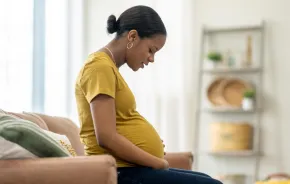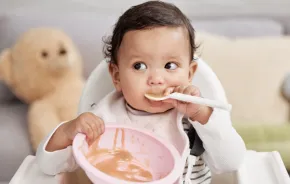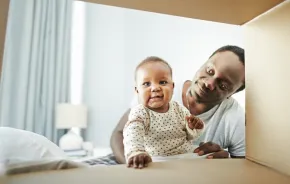 All about your 10-month-old baby!
All about your 10-month-old baby!
Physical Development: Baby’s getting even more mobile — crawling or cruising and standing briefly. He’s using her hands for gestures and wants, says Dr. Mollie Greves Grow of Seattle Children's Hospital.
Brain Development: He’s developing more awareness of words, language and communication as he gets closer to 1 year old, says Grow.
Baby’s cognitive development is also taking leaps and bounds, according to the Mayo Clinic. Baby begins to understand object permanence and he will be able to find hidden objects. Even when you leave the room, your baby has begun to recognize that you still exist. Try hiding a toy under the scarf and then removing it when he’s not looking. Your 8-month-old would have been puzzled, according to the American Academy of Pediatrics' healthychildren.org. But by 10 months, he’ll be so certain that the toy still exists that he’ll continue looking for it. To help your baby learn object permanence, continue to play peekaboo with him. By switching from one variation of this game to another, you’ll maintain his interest almost indefinitely.
Your baby might also be able to identify the correct object when you name it.
Social development: His separation anxiety may increase, his vocalizations will increase and so do his gestures, says Grow. Separation anxiety usually peaks between 10 and 18 months, and fades during the second half of the first year, according to healthychildren.org.
Fun fact or milestone: He can wave bye-bye and may start imitating sounds, like animal noises or words he has heard, says Grow.
What to watch for/common concerns: Separation anxiety might distress you and your child at this stage, but it’s perfectly normal. Some tips from the AAP (more tips and tricks here):
- Your baby is more susceptible to separation anxiety when he’s tired, hungry or sick. If you know you’re going to go out, schedule your departure so that it occurs after he’s napped and eaten. And try to stay with him as much as possible when he’s sick.
- Don’t make a fuss over your leaving. Instead, have the person staying with him create a distraction (a new toy, a visit to the mirror, a bath). Then say goodbye and slip away quickly.
- Help him learn to cope with separation through short practice sessions at home. Separation will be easier when he initiates it, so when he crawls to another room (one that’s babyproofed) don’t follow him right away. Wait for one or two minutes. When you have to go to another room for a few seconds, tell him where you’re going and that you’ll return. If he fusses, call to him instead of running back. Gradually he’ll learn that nothing terrible happens when you’re gone and, just as important, that you always come back when you say you will.
One important thing you can do for your baby: Be sure to leave baby with a known and trusted caretaker he is already comfortable with. You can begin to use some attachment objects — like a stuffed animal or a blanket — he can have with him when you leave, says Grow.
More child development milestones:
- Baby at 1 month old
- Baby at 2 months old
- Baby at 3 months old
- Baby at 4 months old
- Baby at 5 months old
- Baby at 6 months old
- Baby at 7 months old
- Baby at 8 months old
- Baby at 9 months old
- Baby at 10 months old
- Baby at 11 months old
- Baby at 12 months old
- More baby topics











